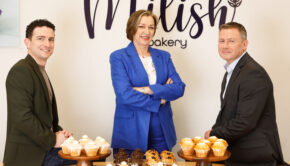Irish consumer sentiment slips as living costs surge and conflict worries emerge: KBC Ireland

Consumer confidence hit by increased price pressures and Ukraine tensions, writes KBC Ireland's Austin Hughes
1 March 2022
While wind and rain lashed Ireland in February, an increasingly stormy economic and financial outlook prompted renewed weakness in consumer sentiment.
Irish consumer confidence buckled on increasing worries around living costs in general and housing costs in particular while emerging fears around conflict in Ukraine more than outweighed easing Covid concerns. In spite of growing nervousness among Irish consumers, the February survey did suggest increasing optimism about job prospects.
The KBC Bank consumer sentiment index slipped to 77.0 in February from 81.9 in January. This reversed most but not all of the improvement seen last month (from a 74.9 reading in December). As such, the February reading is probably best seen as reflecting continuing consumer nervousness in the face of an uncertain but clearly challenging economic climate.
The 4.9 point decline in the sentiment index between January and December points to a clear but not dramatic change in consumer thinking of late. The relatively contained drop is partly because Irish consumers have largely ‘defensive’ in their thinking for some considerable time. As a result, caution has been the most prominent feature of consumer confidence readings through much of the past decade.
The modest monthly fall is also due to the fact that although living cost strains have intensified of late, they have been a source of concern for consumers for some time. Finally, developments in Ukraine clearly pose downside risks but the extent and length of the difficulties they may cause for Irish consumers remains very unclear.
In an important sense, the step-up in concerns around living costs and the heightened nervousness around developments in Ukraine evident in the February survey are simply the latest symptoms of an increasingly volatile environment in which ‘known’ concerns-such as living costs – can markedly increase while ‘unknown’ sources of risk-such as Ukraine – can materialise out of nowhere.
Although the survey period saw the release of several commentaries suggesting a relatively upbeat outlook for Irish economic activity, the most notable ‘macro’ development through the survey period was a much increased focus on data showing an acceleration in the pace of increase in consumer prices and housing costs. Moreover, the details and discussions around these data suggested the likely persistence of problems in these areas. The survey period also saw the emerging prospect of an associated increase in borrowing costs.
With a rapidly deteriorating international geopolitical situation centred on Ukraine adding to downside risks, it is scarcely surprising that the twelve month outlook for the Irish economy was the weakest element of the February sentiment survey and showed the sharpest decline. As a result, twice as many consumers surveyed expect the Irish economy to weaken in the next twelve months as expect it to strengthen.
Encouragingly, if perhaps surprisingly, the jobs element of the survey posted a clear and material improvement in February that likely reflects anecdotal as well as statistical reports pointing to strong positive momentum in the Irish jobs market at present. In stark and unusual contrast, to views on the general economic outlook, more consumers expect unemployment to fall than to rise in the coming year.
While the sentiment survey was completed before the release of labour force data for the 4th quarter of 2021, the positive tone of responses to the sentiment survey is entirely consistent with the buoyant employment picture presented in official data and anecdotal reports of late. A key uncertainty for consumers and the Irish economic outlook more generally is whether the jobs market can remain resilient in the face of the risks now weighing on other elements of the survey.
If the ‘macro’ influences on consumer sentiment were mixed in February, there was a very clear and consistent downgrading across all elements of the survey related to household finances.
Consumers marked down to a broadly similar degree both their assessment of how their financial circumstances had changed through the past twelve months and how they expect them to evolve in the next twelve months. As a result, roughly one in seven consumers now see improvements in their financial circumstances while just under one in three see their personal financial circumstances worsening.
In circumstances where official data and survey responses indicate employment is improving, these February survey responses appear to be the result of growing concerns around rapidly increasing living costs. At the margin, media reports of an emerging consumer boom likely heighten a sense of exclusion from an economic upswing for many consumers that further depresses their assessment of their own financial circumstances.
In this context, a notable element of the February sentiment reading was a substantial worsening of the buying climate. Responses to the regular survey question as to whether now is a good time to buy big ticket items were at their weakest in eighteen months.
While some element of the monthly drop may be a normal retracement after the end of price discounting in post-Christmas sales and some also reflects the effects of supply chain disruptions on availability and pricing on specific products, our sense is that the particular weakness of the February reading in this area is due to markedly increased worries around sharp increases in living costs.
Will pandemic savings trigger a spending surge?
Alongside the regular questions in the February sentiment survey, we asked a special question on the purposes to which savings built during the pandemic were being put. The intention was to assess the extent to which these might be run down in 2022, potentially adding a substantial additional element to consumer spending power. Responses to this question are set out in the table below.
Reflecting the uneven nature of pandemic impacts as well as significant pre-existing differences in household financial circumstances, it is not surprising that the largest category of responses to this question was the 33% of households that said they did not build additional savings during the pandemic.
A further significant tranche-reflecting the additional savings of some 26% of respondents, has already found its way into the Irish economy. This comprises both the 11% of respondents that allocated their extra savings to specific purposes and the 15% who used it in their general spending. The latter result might suggest that the increment to saving was fairly modest for quite a few consumers.
For another significant number-some 11% of respondents- additional savings will be used to fund long term ‘investment’ in housing and/or education. It seems likely that a material amount of this component is now held as prospective deposits in the accounts of would-be homebuyers. On fairly crude mechanical assumptions regarding the various relevant elements of these responses, it might be suggested that homebuying power has been boosted by something in the region of €1bn.
In turn, it might be inferred that the survey findings suggest the additional savings realised during the pandemic could add something in the region of 5 percentage points cumulatively to Irish house prices. (This calculation relates additional property focussed-savings to the €15.7bn spent on residential properties by household buyers in 2021).
In light of the increased frequency of unpleasant ‘unknowable unknowns’ visited upon Irish consumers in recent years (ranging from Brexit through to the pandemic and the emerging risk of military conflict in Europe), it is scarcely surprising that a significant 17% of respondents say they will hold onto additional savings for ’rainy day’ purposes. The increased importance of ‘precautionary’ savings may be a lasting legacy of the volatile economic environment of recent years. The same environmental factors may be an element in the 8% of responses that say they are unsure what they will do with the money.
Perhaps the most surprising aspect of responses to this question was that only a relatively small 5% of respondents say they will spend their additional savings in the year ahead. This suggests the frequently cited ‘wall of money’ that might be unleashed in the form of a surge in household spending on goods and services may be more modest than is sometimes suggested. On fairly crude assumptions (that the amounts involved follow a similar distribution to the share of respondents), it might be inferred that this would boost Irish consumer spending by about 0.5% in 2022.
The KBC Consumer Sentiment Survey is a monthly survey of a nationally representative sample of 1,000 adults. Since May 2019, Core Research have undertaken the survey administration and data collection for the KBC Bank Ireland Consumer Sentiment Survey.



 Print
Print






Fans 0
Followers